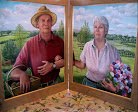 |
| Killodiernan Church in its everchanging flowering churchyard |
I've been leading Morning Worship with the Community of Brendan the Navigator every 2nd Tuesday of the month in Killodiernan Church, Puckane, Co Tipperary, for some years now. Killodiernan churchyard is a special place. The grass is mowed in strips along paths and around graves, but after a winter cut the rest is allowed to grow long, to flower and set seed, before being cut short late in the year. Apart from holding the graves of generations of local families who have worshipped in the church, it is also one of the few pieces of unimproved limestone grassland in the area, beautifully displaying a full range of native plants flowering in succession through the seasons, plus a few naturalised non-native species. And it also supports a wide range of animals that depend on them.
Pilgrimage, as an encounter with the numinous in God's beautiful creation, is a core value for the Community. So after the monthly services I have decided to hold a short walking pilgrimage to pay attention to the marvellous diversity of life in the churchyard, God's good creation in miniature, taking photos to record what we have found, starting this month in May 2025.
 |
| Early Purple Orchids, Orchis mascula |
Early Purple Orchids are the standout species just now. This year they have increased to a dozen or so flowering heads on the sunny right side of the path running up to the porch on the north side of the church. Bugle, often mistaken for an orchid, is also starting to flower in the same area, along with Pignut. False Oxlip, Primula x polyantha, the natural hybrid between a primrose and a cowslip, is just going over. Apart from these showy flowers, you can see from the photos a host of grasses and other species which will have their own moments of glory in the coming months. In a square foot of the turf it is easy to find ten or a dozen different species.
 |
| Bugle, Ajuga reptans |
 |
| The white umbels of Pignut, Conopodium majus. |
 |
| False Oxlip, Primula x polyantha |
While beautifully diverse, this limestone grassland is not entirely natural. Grazing animals, and human mowing is neccessary to maintain it. Without that it would soon revert to scrub as taller species such as willow and brambles grow up, and ultimately woodland, with a completely different range of species. In the photo below you can see a seedling oak, from an acorn sown by some bird or mammal. And there are also a number of willows which get cut down every year.
 |
| The redish leaves of an oak seedling |
Walking anticlockwise past the tower at the west end of the church, in a shady part of the churchyard, we encountered a sheet of Bluebells, just going over and setting seed, with more Pignut, and a Dandelion or two.
 |
| Bluebells, Hyacinthoides non-scripta, just going over |
Turning the corner along the south end of the church, we found evidence of the bats which have a summer, maternity roost in the roofspace. When the church was re-roofed many years ago, the parish commissioned a bat survey, which found 3 different species present - Common and Soprano Pipistrelles, and Lesser Horseshoe. Measures were taken to protect them during the work. They disappeared for a few years, but then returned. The church is very blessed to have them - and the bat guano is an excellent fertiliser for some parishioners gardens!
 |
| A centimetre or more of bat guano on the path around the church |
Moving around the corner to the east end of the church, the species change again. Here a host of Twayblade orchids are just pushing up their spikes of green flowers like tiny green men. Other orchids grow here too, which will be seen in future months. Just coming out now, we also saw Red Clover and yellow Bird's-foot Trefoil.
 |
| Twayblade orchids, Listera ovata |
 |
| Red Clover, Trifolium pratense with Bird's-foot Trefoil, Lotus corniculatus |
Finally, to close our walking pilgrimage, we also admired the Fairy Foxglove, Erinus alpinus growing in the churchyard wall along the road. This is not a native, but introduced from Southern Europe and North Africa. It will only grow in limy conditions, and it has flourished for many years in the lime-mortar filled cracks of the churchyard wall. Such a pretty thing.
 |
| Fairy Foxglove, Erinus alpinus |
Loving Father, Lord of Creation, we thank you for the wonder of the world in which we live: for the earth and all that springs from it; for the mystery of life and growth, and for the bounteous resources you have given us.
We pray that your Holy Spirit may guide leaders to take the decisions necessary to protect your fragile planet and all its creatures.
And we pray that every one of us may learn to tread lightly on your planet, and share your good gifts with your spirit of generosity in peace and justice.
.jpg)
.jpg)



.jpg)

.jpg)
.jpg)







.jpg)
.jpg)
.jpg)

.jpg)

.jpg)
.jpg)
.jpg)








.jpg)









